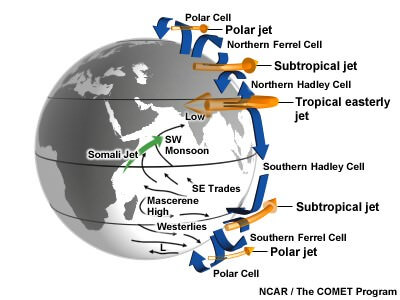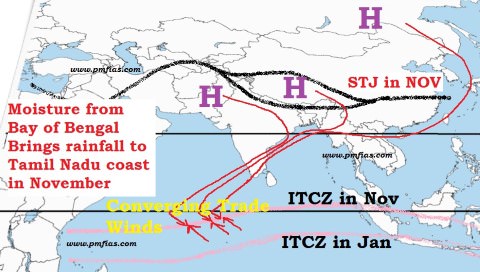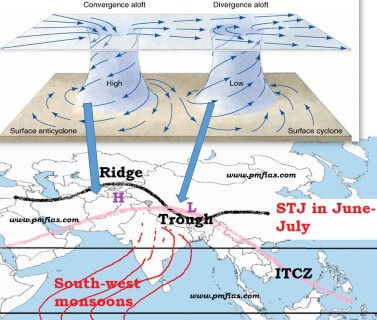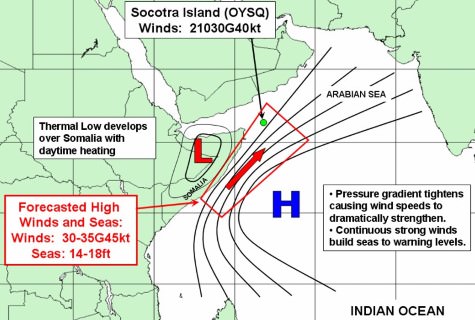Indian Monsoons: Role of Tropical Easterly Jet, Tibet, Somali Jet & Indian Ocean Dipole
Table of Contents
Indian Monsoons – Role of Tropical Easterly Jet (TEJ) [African Easterly Jet], Indian Monsoons – Role of Tibet, Indian Monsoons – Role of Somali Jet and Indian Monsoons – Role of Indian Ocean Dipole.
- Indian Monsoons |ITCZ|Inter-Tropical Convergence Zone
- Indian Monsoons Mechanism|Jet Stream Theory
- Indian Monsoons – Easterly Jet|Tibet|Somali Jet <– You are Here
- Indian Monsoons – South West|North East Monsoons
Indian Monsoons – Role of Tropical Easterly Jet (TEJ) [African Easterly Jet]
- The establishment and maintenance of the TEJ is not fully understood but it is believed that the jet may be caused by the uniquely high temperatures and heights over the Tibetan Plateau during summer.
- The TEJ plays an important role in kick starting southwest monsoon.
- This jet descends over the Indian Ocean (near Madagascar) and intensifies its high pressure cell so as to move as south-west monsoon.
Tropical Easterly Jet (TEJ)
- There are major high velocity winds in the lower troposphere called low-level jets (LLJs).
- In the tropics, the most prominent of these are the Somali Jet and the African Easterly Jet [Tropical Easterly Jet].
- The TEJ is a unique and dominant feature of the northern hemispheric summer over southern Asia and northern Africa. The TEJ is found near between 5° and 20°N.
- It is fairly persistent in its direction, and intensity from June through the beginning of October. It’s position fluctuates between 5° and 20°N.
- TEJ comes into existence quickly after the STJ has shifted to the north of the Himalayas (Early June).
- TEJ flows from east to west over peninsular India at 6 – 9 km and over the Northern African region.
- The formation of TEJ results in the reversal of upper air circulation patterns [High pressure switches to low pressure] and leads to the quick onset of monsoons.
- Recent observations have revealed that the intensity and duration of heating of Tibetan Plateau has a direct bearing on the amount of rainfall in India by the monsoons.
- When the summer temperature of air over Tibet remains high for a sufficiently long time, it helps in strengthening the easterly jet and results in heavy rainfall in India.
- The easterly jet does not come into existence if the snow over the Tibet Plateau does not melt. This hampers the occurrence of rainfall in India.
- Therefore, any year of thick and widespread snow over Tibet will be followed by a year of weak monsoon and less rainfall.

Indian Monsoons – Role of Tibet
- The Tibetan Plateau is an enormous block of highland acting as a formidable barrier.
- Due to its protruded height it receives 2-3°C more insolation than the neighboring areas.
- The plateau affects the atmosphere in two ways: (a) as a mechanical barrier, and (b) as a high- level heat sources.
- At the beginning of June the subtropical jet stream is completely withdrawn from India and occupies a position along 40° N (to the north of Tibetan Plateau).
- The plateau accentuates the northward displacement of the jet stream. Hence the burst of monsoon in June is prompted by the Himalayas and not by the thermally induced low pressure cell over Tibet. (Tibetan plateau is responsible for south-west monsoons. But it is the STJ that facilitates sudden outburst of monsoons with its sudden northward migration)
- In the middle of October the plateau proves to be the most important factor in causing the advance of the jet south of the Himalayas or bifurcating it into two parts.
- The winter Tibetan Plateau cools rapidly and produces a high pressure cell. (Cyclonic condition over Tibet ceases and an anticyclonic condition is established). The high pressure cell over Tibet strengthens N-E monsoons.
- Tibet gets heated in summer and is 2°C to 3°C warmer than the air over the adjoining regions.
- Because the Tibet Plateau is a source of heat for the atmosphere, it generates an area of rising air (convergence)(intense low pressure cell).
- During its ascent the air spreads outwards in upper troposphere (divergence) and gradually sinks (subsidence) over the equatorial part of the Indian Ocean.
- It finally approaches the west coast of India as a return current from a south-westerly direction and is termed as equatorial westerlies.
- It picks up moisture from the Indian Ocean and causes rainfall in India and adjoining countries.


Indian Monsoons – Role of Somali Jet
- Polar and subtropical jet streams are the permanent jet streams which greatly influence the weather of temperate regions.
- Temporary jet streams are narrow winds with speeds more than 94 kph in the upper, middle and sometimes in lower troposphere. They are few. Important ones are Somali Jet and The African Easterly jet or Tropical Easterly Jet.
- These two jet streams play an important role in the formation and progression of Indian Monsoons.
- The progress of the southwest monsoon towards India is greatly aided by the onset of Somali jet that transits Kenya, Somalia and Sahel.
- It was observed to flow from Mauritius and the northern part of the island of Madagascar before reaching the coast of Kenya at about 3º S.
- It strengthens permanent high near Madagascar and also helps to drive S-W monsoons towards India at a greater pace and intensity.
- The importance of the low level jet arises from the fact that its path around 9º N coincides with a zone of coastal upwelling.
- As the strong winds drive away the surface coastal waters towards the east, extremely cold water from the depths of the sea rise upwards to preserve the continuity of mass.
- The peculiar feature of Somali Current is reversal in direction with the onset of the summer monsoon.
- In winter, this current is from north to the south running southwards from the coast of Arabia to the east African coastline; but with the advent of the summer monsoon it reverses its direction and flows from the south to the north.

Indian Monsoons – Role of Indian Ocean Dipole
- Indian ocean Dipole is a recently discovered phenomena that has a significant influence on Indian monsoons.
- Indian ocean Dipole is a SST anomaly (Sea Surface Temperature Anomaly – different from normal) that occurs occasionally in Northern or Equatorial Indian Ocean Region (IOR).
- The Indian Ocean Dipole (IOD) is defined by the difference in sea surface temperature between two areas (or poles, hence a dipole) – a western pole in the Arabian Sea (western Indian Ocean) and an eastern pole in the eastern Indian Ocean south of Indonesia.
- IOD develops in the equatorial region of Indian Ocean from April to May peaking in October.
- With a positive IOD winds over the Indian Ocean blow from east to west (from Bay of Bengal towards Arabian Sea). This results in the Arabian Sea (western Indian Ocean near African Coast) being much warmer and eastern Indian Ocean around Indonesia becoming colder and dry.
- In the negative dipole year, reverse happens making Indonesia much warmer and rainier.
- Positive IOD is good for Indian Monsoons as more evaporation occurs in warm water.
- Similar to ENSO, the atmospheric component of the IOD is named as Equatorial Indian Ocean Oscillation (EQUINOO)(Oscillation of pressure cells between Bay of Bengal and Arabian Sea).
- During the positive phase of the ‘Equatorial Indian Ocean Oscillation (EQUINOO),’ there is enhanced cloud formation and rainfall in western part of the equatorial ocean near the African coast while such activity is suppressed near Sumatra.
- While EQUINOO and IOD go in step during strong positive IOD events, they do not always do so.

No comments:
Post a Comment